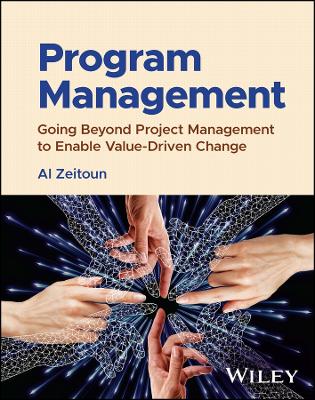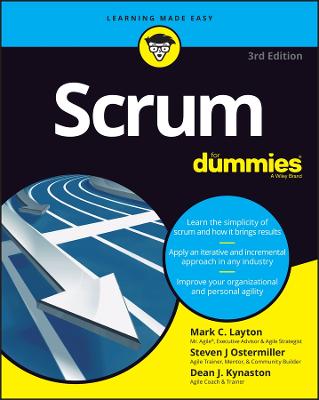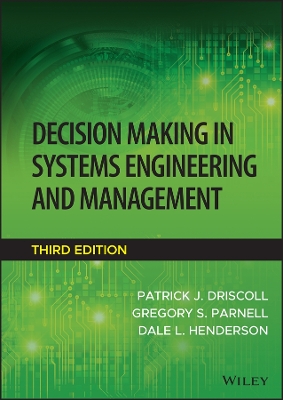Program Management
 -10%
portes grátis
-10%
portes grátis
Program Management
Going Beyond Project Management to Enable Value-Driven Change
Zeitoun, Al
John Wiley & Sons Inc
01/2024
336
Dura
Inglês
9781119931287
15 a 20 dias
Descrição não disponível.
Preface xi
Introduction The Why of Program Management 1
Background 1
Differences Between Programs and Projects 2
Why this Book 6
Approach 7
The Expected Outcomes 7
Section I Governing with Excellence and Achieving Change 9
Section Overview 9
Section Learnings 9
Key Words 9
Introduction 10
Program Management Challenges 10
Types of Projects 11
Program Business Case 11
Scope Creep 11
Organizational Charts 12
Managing Stakeholder Expectations 12
Status Reporting 13
Strategic Alignment 13
Selecting a Methodology 13
Defining Success 14
Chapter 1 Connecting to Purpose and Achieving Change 15
1.1 Programs Matter 15
1.2 Alignment Across Delivery 19
1.3 Speed and Quality of Decisions 26
1.4 The Conductor 29
1.5 Elaborating Through Complexity 32
1.6 Managing Change Matters 36
1.7 Aligning Across Hearts and Minds 39
1.8 Digital Transformation 43
1.9 The Change Maker 47
1.10 Championing Change 49
Chapter 2 Creating Focus 55
2.1 The Program Sponsor 55
2.2 A Critical Partnership 59
2.3 The Stakeholder Link 63
2.4 The Program Charter and Clear Prioritization 67
2.5 Thinking Again for a Change 71
Chapter 3 Driving Integration 75
3.1 The Holistic Leader 75
3.2 The Benefits Focus 79
3.3 Integrating with Empathy 82
3.4 Communicating with the Program Roadmap 84
3.5 Powerful Storytelling 88
Section II Applying Power Skills and Digital Enablers to Create Continual Change 93
Section Overview 93
Section Learnings 93
Key Words 94
Chapter 4 Change Making 95
4.1 The Future of Business 95
4.2 Change Culture 99
4.3 Change Matters 101
4.4 The Inspiring Program Stories 105
4.5 Transformation Qualities 107
Chapter 5 Effective Engaging 111
5.1 Adapting Across the Life Cycle 111
5.2 Program Stakeholders 114
5.3 Engaging Stakeholders 117
5.4 Engagement Strategies for Fit 119
5.5 Sensing and Responding 121
Chapter 6 Power Skills 125
6.1 The Skills Revolution 125
6.2 Not Soft Skills Anymore 129
6.3 The Program Success Link 132
6.4 Power Skills Mastery 135
6.5 The Program Manager Professional 138
Chapter 7 Digitized Future 143
7.1 AI is Here to Stay 143
7.2 The Digital Edge 147
7.3 Managing with Intelligence 150
7.4 Communicating is Human 153
7.5 Achieving Balance 155
Section III The Program Management Office (PMO) - The Strategy Execution Arm 159
Section Overview 159
Section Learnings 159
Key Words 160
Chapter 8 Value- Driven Programs and Hybrid Work 161
8.1 Value- Driven Way of Working 161
8.2 The Value Mindset 164
8.3 Benefits Management Matters 167
8.4 Initiatives Success 169
8.5 Imbedding the Value Focus 171
8.6 The Hybrid Way of Working 174
8.7 Cocreating the Program Approach 177
8.8 Value of Flexible Delivery 179
8.9 Program Life Cycle Choices 182
8.10 Organizing Teams for Fit 184
Chapter 9 Risk- Based Governance 187
9.1 Why Risk- Based Program Governance Matters? 187
9.2 The Cascading Effect of the Risk Appetite 190
9.3 Decision- Making Speed 193
9.4 Integration with Learning 196
9.5 Maturing Program Management Practice 197
Chapter 10 The Learning Engine 205
10.1 The Enterprise Learning Muscles 205
10.2 Developing Role of the PMO 208
10.3 Creating the Learning Culture 210
10.4 Criticality of Cross- Programs Alignment 213
10.5 Guided Continuous Improvement 215
Section IV Organizational Change Management Framework - Transforming Strategy Execution to Realize Program Value 219
Section Overview 219
Section Learnings 219
Key Words 220
Chapter 11 Change Culture 221
11.1 The Features of Change Culture 221
11.2 Change Success Ingredients 223
11.3 Governance Matters 226
11.4 ERM- Based Governance 227
11.5 Supporting Change Success 230
Chapter 12 Sustaining Benefits 233
12.1 Benefits Across the Lifecycle 233
12.2 Resiliency and Benefits 240
12.3 An Ownership Environment Matters 242
12.4 Managing for Trust 244
12.5 Change and Benefits Consistency 246
Chapter 13 Change Scientists 249
13.1 The Change Scientists' Revolution 250
13.2 The Power Skill for Program Success 251
13.3 The Program Metrics mix 254
13.4 Decision- Making Mastery 256
13.5 The Program Core Team Changes 259
Chapter 14 Adaptable Roadmaps 263
14.1 Value- Based Program Roadmaps 263
14.2 The Adapting Factor 265
14.3 Balancing Governance with Traceability 268
14.4 Cocreated Roadmaps 271
14.5 Diversity Consistency 274
Section V The Path Forward 279
Strategic Opportunities For Program Management 279
Case Study: Nora's Dilemma 285
Case Study: The Blue Spider Project 287
Case Study: McRoy Aerospace 298
Case Study: The Team Meeting 299
Case Study: The Prima Donna 301
Case Study: Zane Corporation 302
The Project Management Landscape Changes 302
Case Study: The Poor Team Performer 304
Case Study: The Management Control Freak 304
Leading and Sustaining Future Change 306
Index 315
Introduction The Why of Program Management 1
Background 1
Differences Between Programs and Projects 2
Why this Book 6
Approach 7
The Expected Outcomes 7
Section I Governing with Excellence and Achieving Change 9
Section Overview 9
Section Learnings 9
Key Words 9
Introduction 10
Program Management Challenges 10
Types of Projects 11
Program Business Case 11
Scope Creep 11
Organizational Charts 12
Managing Stakeholder Expectations 12
Status Reporting 13
Strategic Alignment 13
Selecting a Methodology 13
Defining Success 14
Chapter 1 Connecting to Purpose and Achieving Change 15
1.1 Programs Matter 15
1.2 Alignment Across Delivery 19
1.3 Speed and Quality of Decisions 26
1.4 The Conductor 29
1.5 Elaborating Through Complexity 32
1.6 Managing Change Matters 36
1.7 Aligning Across Hearts and Minds 39
1.8 Digital Transformation 43
1.9 The Change Maker 47
1.10 Championing Change 49
Chapter 2 Creating Focus 55
2.1 The Program Sponsor 55
2.2 A Critical Partnership 59
2.3 The Stakeholder Link 63
2.4 The Program Charter and Clear Prioritization 67
2.5 Thinking Again for a Change 71
Chapter 3 Driving Integration 75
3.1 The Holistic Leader 75
3.2 The Benefits Focus 79
3.3 Integrating with Empathy 82
3.4 Communicating with the Program Roadmap 84
3.5 Powerful Storytelling 88
Section II Applying Power Skills and Digital Enablers to Create Continual Change 93
Section Overview 93
Section Learnings 93
Key Words 94
Chapter 4 Change Making 95
4.1 The Future of Business 95
4.2 Change Culture 99
4.3 Change Matters 101
4.4 The Inspiring Program Stories 105
4.5 Transformation Qualities 107
Chapter 5 Effective Engaging 111
5.1 Adapting Across the Life Cycle 111
5.2 Program Stakeholders 114
5.3 Engaging Stakeholders 117
5.4 Engagement Strategies for Fit 119
5.5 Sensing and Responding 121
Chapter 6 Power Skills 125
6.1 The Skills Revolution 125
6.2 Not Soft Skills Anymore 129
6.3 The Program Success Link 132
6.4 Power Skills Mastery 135
6.5 The Program Manager Professional 138
Chapter 7 Digitized Future 143
7.1 AI is Here to Stay 143
7.2 The Digital Edge 147
7.3 Managing with Intelligence 150
7.4 Communicating is Human 153
7.5 Achieving Balance 155
Section III The Program Management Office (PMO) - The Strategy Execution Arm 159
Section Overview 159
Section Learnings 159
Key Words 160
Chapter 8 Value- Driven Programs and Hybrid Work 161
8.1 Value- Driven Way of Working 161
8.2 The Value Mindset 164
8.3 Benefits Management Matters 167
8.4 Initiatives Success 169
8.5 Imbedding the Value Focus 171
8.6 The Hybrid Way of Working 174
8.7 Cocreating the Program Approach 177
8.8 Value of Flexible Delivery 179
8.9 Program Life Cycle Choices 182
8.10 Organizing Teams for Fit 184
Chapter 9 Risk- Based Governance 187
9.1 Why Risk- Based Program Governance Matters? 187
9.2 The Cascading Effect of the Risk Appetite 190
9.3 Decision- Making Speed 193
9.4 Integration with Learning 196
9.5 Maturing Program Management Practice 197
Chapter 10 The Learning Engine 205
10.1 The Enterprise Learning Muscles 205
10.2 Developing Role of the PMO 208
10.3 Creating the Learning Culture 210
10.4 Criticality of Cross- Programs Alignment 213
10.5 Guided Continuous Improvement 215
Section IV Organizational Change Management Framework - Transforming Strategy Execution to Realize Program Value 219
Section Overview 219
Section Learnings 219
Key Words 220
Chapter 11 Change Culture 221
11.1 The Features of Change Culture 221
11.2 Change Success Ingredients 223
11.3 Governance Matters 226
11.4 ERM- Based Governance 227
11.5 Supporting Change Success 230
Chapter 12 Sustaining Benefits 233
12.1 Benefits Across the Lifecycle 233
12.2 Resiliency and Benefits 240
12.3 An Ownership Environment Matters 242
12.4 Managing for Trust 244
12.5 Change and Benefits Consistency 246
Chapter 13 Change Scientists 249
13.1 The Change Scientists' Revolution 250
13.2 The Power Skill for Program Success 251
13.3 The Program Metrics mix 254
13.4 Decision- Making Mastery 256
13.5 The Program Core Team Changes 259
Chapter 14 Adaptable Roadmaps 263
14.1 Value- Based Program Roadmaps 263
14.2 The Adapting Factor 265
14.3 Balancing Governance with Traceability 268
14.4 Cocreated Roadmaps 271
14.5 Diversity Consistency 274
Section V The Path Forward 279
Strategic Opportunities For Program Management 279
Case Study: Nora's Dilemma 285
Case Study: The Blue Spider Project 287
Case Study: McRoy Aerospace 298
Case Study: The Team Meeting 299
Case Study: The Prima Donna 301
Case Study: Zane Corporation 302
The Project Management Landscape Changes 302
Case Study: The Poor Team Performer 304
Case Study: The Management Control Freak 304
Leading and Sustaining Future Change 306
Index 315
Este título pertence ao(s) assunto(s) indicados(s). Para ver outros títulos clique no assunto desejado.
Strategy; strategy execution; power skills; project economy; co-creation; hybrid management; transformation; AI; digitalization; ways of working; change management; mindset; program management; program manager; Project manager; program life cycle; Program activities; program integration; program benefits management; program outcomes; program benefits; program mapping; program costs; program analysis
Preface xi
Introduction The Why of Program Management 1
Background 1
Differences Between Programs and Projects 2
Why this Book 6
Approach 7
The Expected Outcomes 7
Section I Governing with Excellence and Achieving Change 9
Section Overview 9
Section Learnings 9
Key Words 9
Introduction 10
Program Management Challenges 10
Types of Projects 11
Program Business Case 11
Scope Creep 11
Organizational Charts 12
Managing Stakeholder Expectations 12
Status Reporting 13
Strategic Alignment 13
Selecting a Methodology 13
Defining Success 14
Chapter 1 Connecting to Purpose and Achieving Change 15
1.1 Programs Matter 15
1.2 Alignment Across Delivery 19
1.3 Speed and Quality of Decisions 26
1.4 The Conductor 29
1.5 Elaborating Through Complexity 32
1.6 Managing Change Matters 36
1.7 Aligning Across Hearts and Minds 39
1.8 Digital Transformation 43
1.9 The Change Maker 47
1.10 Championing Change 49
Chapter 2 Creating Focus 55
2.1 The Program Sponsor 55
2.2 A Critical Partnership 59
2.3 The Stakeholder Link 63
2.4 The Program Charter and Clear Prioritization 67
2.5 Thinking Again for a Change 71
Chapter 3 Driving Integration 75
3.1 The Holistic Leader 75
3.2 The Benefits Focus 79
3.3 Integrating with Empathy 82
3.4 Communicating with the Program Roadmap 84
3.5 Powerful Storytelling 88
Section II Applying Power Skills and Digital Enablers to Create Continual Change 93
Section Overview 93
Section Learnings 93
Key Words 94
Chapter 4 Change Making 95
4.1 The Future of Business 95
4.2 Change Culture 99
4.3 Change Matters 101
4.4 The Inspiring Program Stories 105
4.5 Transformation Qualities 107
Chapter 5 Effective Engaging 111
5.1 Adapting Across the Life Cycle 111
5.2 Program Stakeholders 114
5.3 Engaging Stakeholders 117
5.4 Engagement Strategies for Fit 119
5.5 Sensing and Responding 121
Chapter 6 Power Skills 125
6.1 The Skills Revolution 125
6.2 Not Soft Skills Anymore 129
6.3 The Program Success Link 132
6.4 Power Skills Mastery 135
6.5 The Program Manager Professional 138
Chapter 7 Digitized Future 143
7.1 AI is Here to Stay 143
7.2 The Digital Edge 147
7.3 Managing with Intelligence 150
7.4 Communicating is Human 153
7.5 Achieving Balance 155
Section III The Program Management Office (PMO) - The Strategy Execution Arm 159
Section Overview 159
Section Learnings 159
Key Words 160
Chapter 8 Value- Driven Programs and Hybrid Work 161
8.1 Value- Driven Way of Working 161
8.2 The Value Mindset 164
8.3 Benefits Management Matters 167
8.4 Initiatives Success 169
8.5 Imbedding the Value Focus 171
8.6 The Hybrid Way of Working 174
8.7 Cocreating the Program Approach 177
8.8 Value of Flexible Delivery 179
8.9 Program Life Cycle Choices 182
8.10 Organizing Teams for Fit 184
Chapter 9 Risk- Based Governance 187
9.1 Why Risk- Based Program Governance Matters? 187
9.2 The Cascading Effect of the Risk Appetite 190
9.3 Decision- Making Speed 193
9.4 Integration with Learning 196
9.5 Maturing Program Management Practice 197
Chapter 10 The Learning Engine 205
10.1 The Enterprise Learning Muscles 205
10.2 Developing Role of the PMO 208
10.3 Creating the Learning Culture 210
10.4 Criticality of Cross- Programs Alignment 213
10.5 Guided Continuous Improvement 215
Section IV Organizational Change Management Framework - Transforming Strategy Execution to Realize Program Value 219
Section Overview 219
Section Learnings 219
Key Words 220
Chapter 11 Change Culture 221
11.1 The Features of Change Culture 221
11.2 Change Success Ingredients 223
11.3 Governance Matters 226
11.4 ERM- Based Governance 227
11.5 Supporting Change Success 230
Chapter 12 Sustaining Benefits 233
12.1 Benefits Across the Lifecycle 233
12.2 Resiliency and Benefits 240
12.3 An Ownership Environment Matters 242
12.4 Managing for Trust 244
12.5 Change and Benefits Consistency 246
Chapter 13 Change Scientists 249
13.1 The Change Scientists' Revolution 250
13.2 The Power Skill for Program Success 251
13.3 The Program Metrics mix 254
13.4 Decision- Making Mastery 256
13.5 The Program Core Team Changes 259
Chapter 14 Adaptable Roadmaps 263
14.1 Value- Based Program Roadmaps 263
14.2 The Adapting Factor 265
14.3 Balancing Governance with Traceability 268
14.4 Cocreated Roadmaps 271
14.5 Diversity Consistency 274
Section V The Path Forward 279
Strategic Opportunities For Program Management 279
Case Study: Nora's Dilemma 285
Case Study: The Blue Spider Project 287
Case Study: McRoy Aerospace 298
Case Study: The Team Meeting 299
Case Study: The Prima Donna 301
Case Study: Zane Corporation 302
The Project Management Landscape Changes 302
Case Study: The Poor Team Performer 304
Case Study: The Management Control Freak 304
Leading and Sustaining Future Change 306
Index 315
Introduction The Why of Program Management 1
Background 1
Differences Between Programs and Projects 2
Why this Book 6
Approach 7
The Expected Outcomes 7
Section I Governing with Excellence and Achieving Change 9
Section Overview 9
Section Learnings 9
Key Words 9
Introduction 10
Program Management Challenges 10
Types of Projects 11
Program Business Case 11
Scope Creep 11
Organizational Charts 12
Managing Stakeholder Expectations 12
Status Reporting 13
Strategic Alignment 13
Selecting a Methodology 13
Defining Success 14
Chapter 1 Connecting to Purpose and Achieving Change 15
1.1 Programs Matter 15
1.2 Alignment Across Delivery 19
1.3 Speed and Quality of Decisions 26
1.4 The Conductor 29
1.5 Elaborating Through Complexity 32
1.6 Managing Change Matters 36
1.7 Aligning Across Hearts and Minds 39
1.8 Digital Transformation 43
1.9 The Change Maker 47
1.10 Championing Change 49
Chapter 2 Creating Focus 55
2.1 The Program Sponsor 55
2.2 A Critical Partnership 59
2.3 The Stakeholder Link 63
2.4 The Program Charter and Clear Prioritization 67
2.5 Thinking Again for a Change 71
Chapter 3 Driving Integration 75
3.1 The Holistic Leader 75
3.2 The Benefits Focus 79
3.3 Integrating with Empathy 82
3.4 Communicating with the Program Roadmap 84
3.5 Powerful Storytelling 88
Section II Applying Power Skills and Digital Enablers to Create Continual Change 93
Section Overview 93
Section Learnings 93
Key Words 94
Chapter 4 Change Making 95
4.1 The Future of Business 95
4.2 Change Culture 99
4.3 Change Matters 101
4.4 The Inspiring Program Stories 105
4.5 Transformation Qualities 107
Chapter 5 Effective Engaging 111
5.1 Adapting Across the Life Cycle 111
5.2 Program Stakeholders 114
5.3 Engaging Stakeholders 117
5.4 Engagement Strategies for Fit 119
5.5 Sensing and Responding 121
Chapter 6 Power Skills 125
6.1 The Skills Revolution 125
6.2 Not Soft Skills Anymore 129
6.3 The Program Success Link 132
6.4 Power Skills Mastery 135
6.5 The Program Manager Professional 138
Chapter 7 Digitized Future 143
7.1 AI is Here to Stay 143
7.2 The Digital Edge 147
7.3 Managing with Intelligence 150
7.4 Communicating is Human 153
7.5 Achieving Balance 155
Section III The Program Management Office (PMO) - The Strategy Execution Arm 159
Section Overview 159
Section Learnings 159
Key Words 160
Chapter 8 Value- Driven Programs and Hybrid Work 161
8.1 Value- Driven Way of Working 161
8.2 The Value Mindset 164
8.3 Benefits Management Matters 167
8.4 Initiatives Success 169
8.5 Imbedding the Value Focus 171
8.6 The Hybrid Way of Working 174
8.7 Cocreating the Program Approach 177
8.8 Value of Flexible Delivery 179
8.9 Program Life Cycle Choices 182
8.10 Organizing Teams for Fit 184
Chapter 9 Risk- Based Governance 187
9.1 Why Risk- Based Program Governance Matters? 187
9.2 The Cascading Effect of the Risk Appetite 190
9.3 Decision- Making Speed 193
9.4 Integration with Learning 196
9.5 Maturing Program Management Practice 197
Chapter 10 The Learning Engine 205
10.1 The Enterprise Learning Muscles 205
10.2 Developing Role of the PMO 208
10.3 Creating the Learning Culture 210
10.4 Criticality of Cross- Programs Alignment 213
10.5 Guided Continuous Improvement 215
Section IV Organizational Change Management Framework - Transforming Strategy Execution to Realize Program Value 219
Section Overview 219
Section Learnings 219
Key Words 220
Chapter 11 Change Culture 221
11.1 The Features of Change Culture 221
11.2 Change Success Ingredients 223
11.3 Governance Matters 226
11.4 ERM- Based Governance 227
11.5 Supporting Change Success 230
Chapter 12 Sustaining Benefits 233
12.1 Benefits Across the Lifecycle 233
12.2 Resiliency and Benefits 240
12.3 An Ownership Environment Matters 242
12.4 Managing for Trust 244
12.5 Change and Benefits Consistency 246
Chapter 13 Change Scientists 249
13.1 The Change Scientists' Revolution 250
13.2 The Power Skill for Program Success 251
13.3 The Program Metrics mix 254
13.4 Decision- Making Mastery 256
13.5 The Program Core Team Changes 259
Chapter 14 Adaptable Roadmaps 263
14.1 Value- Based Program Roadmaps 263
14.2 The Adapting Factor 265
14.3 Balancing Governance with Traceability 268
14.4 Cocreated Roadmaps 271
14.5 Diversity Consistency 274
Section V The Path Forward 279
Strategic Opportunities For Program Management 279
Case Study: Nora's Dilemma 285
Case Study: The Blue Spider Project 287
Case Study: McRoy Aerospace 298
Case Study: The Team Meeting 299
Case Study: The Prima Donna 301
Case Study: Zane Corporation 302
The Project Management Landscape Changes 302
Case Study: The Poor Team Performer 304
Case Study: The Management Control Freak 304
Leading and Sustaining Future Change 306
Index 315
Este título pertence ao(s) assunto(s) indicados(s). Para ver outros títulos clique no assunto desejado.
Strategy; strategy execution; power skills; project economy; co-creation; hybrid management; transformation; AI; digitalization; ways of working; change management; mindset; program management; program manager; Project manager; program life cycle; Program activities; program integration; program benefits management; program outcomes; program benefits; program mapping; program costs; program analysis





